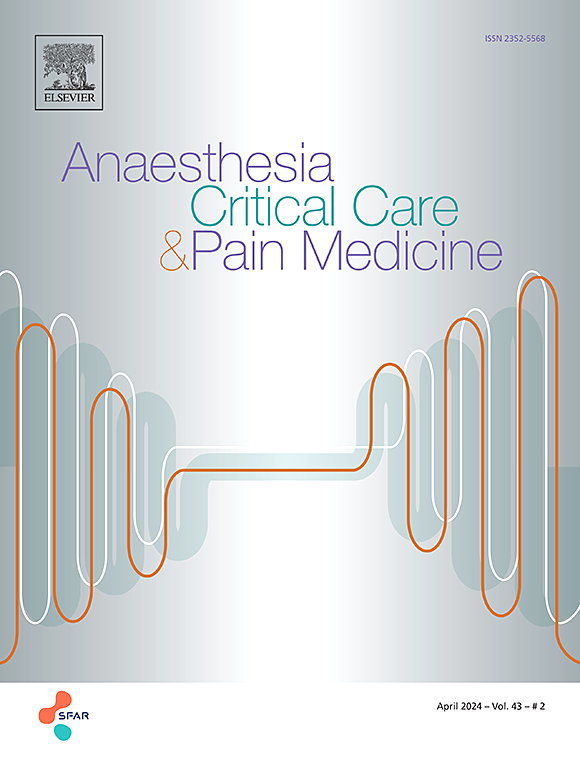亚麻醉剂量艾氯胺酮对腰椎椎体间融合术患者术后睡眠障碍和疼痛的影响——一项随机、双盲、安慰剂对照、双中心试验
IF 4.7
3区 医学
Q1 ANESTHESIOLOGY
引用次数: 0
摘要
背景:术后睡眠障碍(PSD)是一种常见的术后并发症,严重影响患者的康复,尤其是腰椎手术后。方法:这项双中心、双盲、安慰剂对照的随机试验于2024年6月6日至2024年11月26日在中国两家医院进行。共有80例患者参与了本研究,随机分为艾氯胺酮组(n = 40)和安慰剂组(n = 40)。艾氯胺酮组患者术后给予艾氯胺酮0.2 mg kg-¹用于麻醉诱导,维持率为0.02 mg kg-¹·h-¹,术后给予艾氯胺酮1 mg kg-¹辅助患者自行静脉镇痛48 h。给予安慰剂组患者生理盐水。本研究的主要结局是术后一天PSD的发生率(POD) 1。PSD被定义为数值评定量表-睡眠得分为6分或更高或雅典失眠量表得分为6分或更高。结果:与安慰剂组相比,艾氯胺酮组POD 1上PSD的发生率显著降低(33% vs. 67%;P = 0.003)。值得注意的是,术后1、3、6 h,艾氯胺酮组静息时视觉模拟评分(VAS)疼痛评分低于安慰剂组(P)。结论:亚麻醉剂量艾氯胺酮可降低POD1上PSD的发生率,减轻术后疼痛,改善QoR。临床试验注册:中国临床试验注册中心https://www.chictr.org.cn, ChiCTR2400083156。本文章由计算机程序翻译,如有差异,请以英文原文为准。
Effects of sub-anesthetic doses of esketamine on postoperative sleep disturbance and pain in patients undergoing lumbar interbody fusion—A randomized, double-blind, placebo-controlled, two-center trial
Background
Postoperative sleep disturbance (PSD) is a common postoperative complication that significantly impacts patients’ recovery, particularly after lumbar surgery.
Methods
This two-center, double-blind, placebo-controlled randomized trial was conducted between June 6, 2024, and November 26, 2024, in two hospitals in China. A total of 80 patients participated in this study and were randomly assigned to the esketamine group (n = 40) or the placebo group (n = 40). Patients in the esketamine group received 0.2 mg kg−¹ of esketamine for anesthesia induction, with a maintenance rate of 0.02 mg kg−¹ h−¹, followed by 1 mg kg−¹ of esketamine as an adjuvant in patient-controlled intravenous analgesia for 48 h after surgery. Saline was given to the placebo group of patients. The primary outcome of this study was the incidence of PSD on postoperative day (POD) 1. PSD was defined as a Numeric Rating Scale-sleep score of 6 or higher or an Athens Insomnia Scale score of 6 points or higher.
Results
The incidence of PSD on POD 1 was significantly lower in the esketamine group compared to the placebo group (33% vs. 67%; P = 0.003). The Visual Analog Scale (VAS)-pain score at rest was lower in the esketamine group compared to the placebo group at 1, 3, and 6 h after surgery (P < 0.05). The VAS-pain score with movement was also lower in the esketamine group than the placebo group at 1, 3, 6, and 24 h after surgery (P < 0.05). Furthermore, the Quality of Recovery-15 (QoR-15) scores were significantly higher in the esketamine group than in the placebo group on POD 1 (107 [103–117] vs. 99 [96−108]; P = 0.005) and POD 3 (130 [122−136] vs. 124 [117−127]; P = 0.003).
Conclusion
Sub-anesthetic doses of esketamine can reduce the incidence of PSD on POD 1, reduce postoperative pain, and improve QoR.
Clinical trial registration
Chinese Clinical Trial Registry https://www.chictr.org.cn, ChiCTR2400083156.
求助全文
通过发布文献求助,成功后即可免费获取论文全文。
去求助
来源期刊

Anaesthesia Critical Care & Pain Medicine
ANESTHESIOLOGY-
CiteScore
6.70
自引率
5.50%
发文量
150
审稿时长
18 days
期刊介绍:
Anaesthesia, Critical Care & Pain Medicine (formerly Annales Françaises d''Anesthésie et de Réanimation) publishes in English the highest quality original material, both scientific and clinical, on all aspects of anaesthesia, critical care & pain medicine.
 求助内容:
求助内容: 应助结果提醒方式:
应助结果提醒方式:


